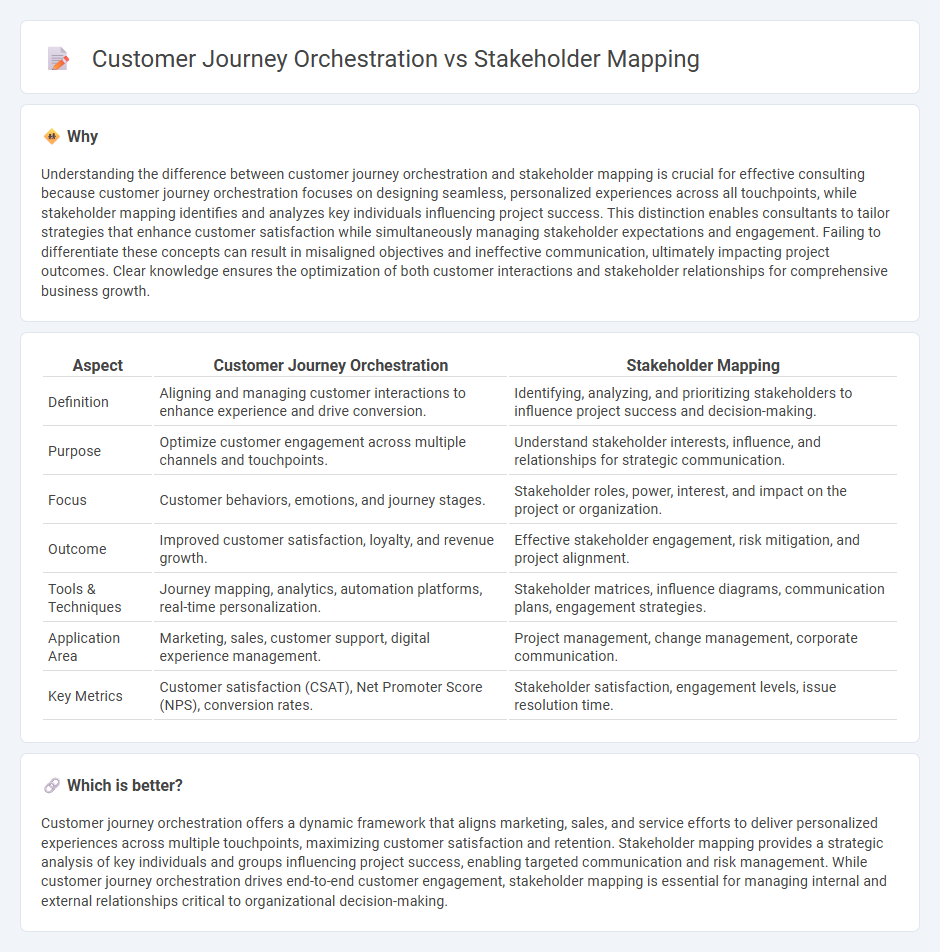
Customer journey orchestration focuses on designing seamless experiences by analyzing and optimizing each touchpoint a customer interacts with across channels. Stakeholder mapping identifies and categorizes key individuals or groups involved in a project to understand their influence, interests, and communication needs. Explore how mastering both approaches can elevate your consulting strategies and drive measurable business outcomes.
Why it is important
Understanding the difference between customer journey orchestration and stakeholder mapping is crucial for effective consulting because customer journey orchestration focuses on designing seamless, personalized experiences across all touchpoints, while stakeholder mapping identifies and analyzes key individuals influencing project success. This distinction enables consultants to tailor strategies that enhance customer satisfaction while simultaneously managing stakeholder expectations and engagement. Failing to differentiate these concepts can result in misaligned objectives and ineffective communication, ultimately impacting project outcomes. Clear knowledge ensures the optimization of both customer interactions and stakeholder relationships for comprehensive business growth.
Comparison Table
| Aspect | Customer Journey Orchestration | Stakeholder Mapping |
|---|---|---|
| Definition | Aligning and managing customer interactions to enhance experience and drive conversion. | Identifying, analyzing, and prioritizing stakeholders to influence project success and decision-making. |
| Purpose | Optimize customer engagement across multiple channels and touchpoints. | Understand stakeholder interests, influence, and relationships for strategic communication. |
| Focus | Customer behaviors, emotions, and journey stages. | Stakeholder roles, power, interest, and impact on the project or organization. |
| Outcome | Improved customer satisfaction, loyalty, and revenue growth. | Effective stakeholder engagement, risk mitigation, and project alignment. |
| Tools & Techniques | Journey mapping, analytics, automation platforms, real-time personalization. | Stakeholder matrices, influence diagrams, communication plans, engagement strategies. |
| Application Area | Marketing, sales, customer support, digital experience management. | Project management, change management, corporate communication. |
| Key Metrics | Customer satisfaction (CSAT), Net Promoter Score (NPS), conversion rates. | Stakeholder satisfaction, engagement levels, issue resolution time. |
Which is better?
Customer journey orchestration offers a dynamic framework that aligns marketing, sales, and service efforts to deliver personalized experiences across multiple touchpoints, maximizing customer satisfaction and retention. Stakeholder mapping provides a strategic analysis of key individuals and groups influencing project success, enabling targeted communication and risk management. While customer journey orchestration drives end-to-end customer engagement, stakeholder mapping is essential for managing internal and external relationships critical to organizational decision-making.
Connection
Customer journey orchestration relies on detailed stakeholder mapping to identify key decision-makers and influencers across various touchpoints, enabling tailored communication strategies and seamless experience delivery. By mapping stakeholders, consulting firms can align resources and messaging to address specific needs and pain points throughout the customer lifecycle. This integration enhances personalized engagement, drives customer satisfaction, and optimizes business outcomes.
Key Terms
**Stakeholder Mapping:**
Stakeholder mapping identifies and categorizes individuals or groups with interest or influence in a project, enabling targeted communication and resource allocation. It highlights relationships, power dynamics, and stakeholder priorities to optimize engagement strategies. Explore deeper insights into stakeholder mapping to enhance project success and collaboration.
Influence Grid
Stakeholder mapping identifies and categorizes key individuals or groups based on their influence and interest, with the Influence Grid serving as a crucial tool to visualize and prioritize these relationships for strategic decision-making. Customer journey orchestration integrates real-time data and touchpoints to dynamically guide customers through personalized experiences, enhancing engagement and conversion rates. Explore how leveraging the Influence Grid within stakeholder mapping can complement customer journey orchestration strategies for optimized business outcomes.
Interest Matrix
Stakeholder mapping identifies and categorizes individuals or groups based on their influence and interest in a project, often visualized through an Interest Matrix to prioritize engagement efforts. Customer journey orchestration focuses on real-time management of customer interactions across touchpoints to enhance personalized experiences and drive conversions. Explore how integrating the Interest Matrix with journey orchestration can optimize stakeholder engagement and elevate customer satisfaction.
Source and External Links
What is Stakeholder Mapping? Techniques and Steps - SixSigma.us - Stakeholder mapping is a strategic tool that visualizes and analyzes the relationships between parties involved in a project or business, typically following a structured process to identify, analyze, and prioritize key stakeholders for effective engagement.
Stakeholder Mapping: Guide to Identifying & Engaging Key ... - This approach involves identifying all relevant stakeholders, categorizing them into groups with similar interests, and refining those groups into smaller subgroups to streamline communication and engagement strategies.
How to create a stakeholder map [templates & examples] - Mural - A stakeholder map is a visual representation (often using grids or network diagrams) that plots individuals or groups by their influence and interest in a project, helping teams identify relationships and tailor communication plans accordingly.
 dowidth.com
dowidth.com